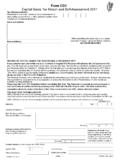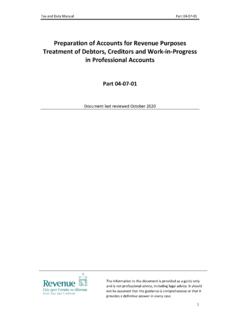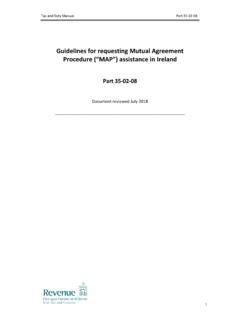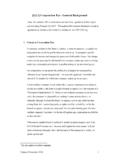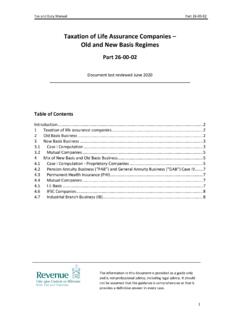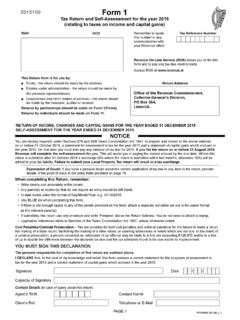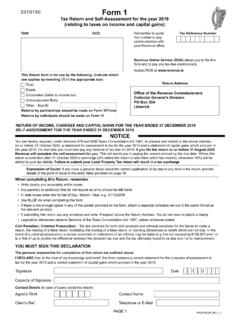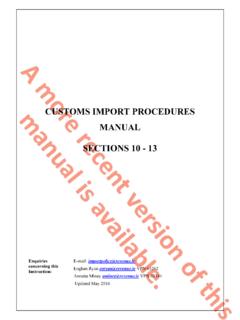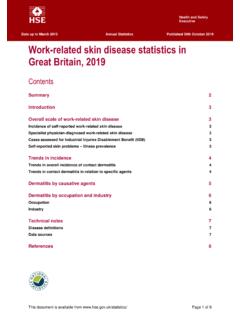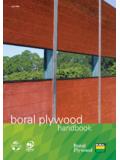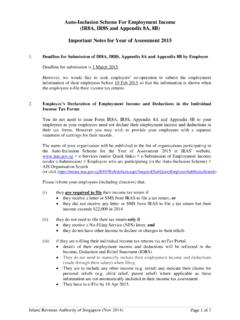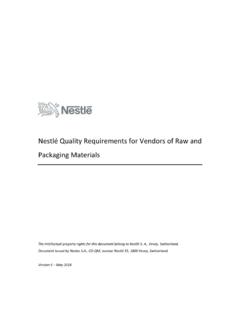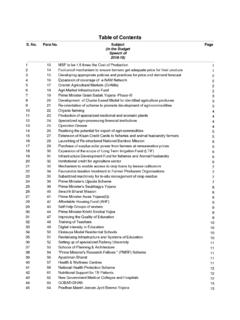Transcription of Contributions by Employers - Revenue
1 Tax and Duty ManualPensions Manual Chapter 4 The information in this document is provided as a guide only and is not professional advice, including legal advice. It should not be assumed that the guidance is comprehensive or that it provides a definitive answer in every by EmployersChapter 4 Document last updated January 2020 Table of annual under one-person allowed in the year of schemes deemed to be exempt approved .. to an approved scheme which is not exempt approved .. of employer in corporate groups and following corporate reorganisations, and Duty ManualPensions Manual Chapter of the conditions for approval of a pension scheme is that the employer must contribute to it (section 772(2)(d) Taxes Consolidation Act 1997 (TCA)).
2 Subject to the considerations mentioned in Chapter 5 and any funding requirements imposed by the Pensions Acts (as regulated by the Pensions Authority) the timing of the Contributions is a matter for the Revenue will not insist that there be a stated minimum level of employer Contributions , such Contributions must be meaningful in the context of the establishment of, operation of, and the provision of benefits under, a scheme. For instance, where an employer bears the cost of establishment and ongoing operation of the scheme, in addition to meeting the costs of the provision of death in service benefits under the scheme, such overall Contributions would generally be considered to be Contributions which amount to not less than 10% of the total ordinary annual Contributions to a scheme (exclusive of employee voluntary Contributions ) would always be considered to be will always be open for Employers and their advisers to approach Revenue to discuss individual schemes .
3 Such queries can be addressed using the secure MyEnquiries service available in myAccount or annual Contributions Ordinary annual Contributions paid by an employer to an exempt approved scheme are allowed as a deduction for tax purposes. Section 774(6) TCA provides that the amount of the Contributions shall be allowed to be deducted as an expense incurred in the year in which the sum is paid. No deduction can be given for any provision for an amount due but not paid. The amount deductible must not exceed the amount contributed by the employer to the scheme in respect of employees engaged in a trade or undertaking, the profits of which are assessable to Irish tax on the employer.
4 Where the employer carries on two or more separate businesses, each with its own employees, the employer's Contributions in respect of each group of employees can be allowed only against the profits of the business in which the group is employed. Please, however, refer to paragraph which considers the position where an employer makes pension Contributions in respect of the employees of another employer in corporate reorganisation see Chapter for the standard methodology for funding and benefit and Duty ManualPensions Manual Chapter ContributionsWhere a contribution is not an ordinary annual contribution but a special contribution (for example, to provide benefits for back service , to augment benefits already secured or to make up an actuarial deficiency in the fund)
5 Revenue may require that the allowance be spread forward over a period of will not normally be required where the aggregate of all special Contributions made by an employer to exempt approved schemes in the same chargeable period does not exceed the greater of the employer's corresponding aggregate ordinary annual Contributions or 6, period of the spread is usually determined by dividing the aggregate special contribution by the aggregate ordinary annual contribution, subject to a maximum of five years and to a minimum divisor of 6, the following examples, OAC stands for ordinary annual contribution and SC stands for special contribution.
6 (A)(B)(C)(D) OAC SC (B)/(A) AllowanceMax. spread 2,000 40,00020 *1st year 8,0002nd year 8,0003rd year 8,0004th year 8,0005th year 8,000* The minimum divisor is 6,350, which would give a spread of years ( 40,000 / 6,350). However, the maximum spread is five divisor to determine the spread period for a special contribution paid during a short chargeable period will normally be equal to the greater of the actual ordinary annual contribution paid during the short period in question orTax and Duty ManualPensions Manual Chapter 44 6, the quotient exceeds 1 but does not exceed , the special contribution will be allowed over two years.
7 (A) (B) (C) (D)OAC SC (B)/(A)AllowanceRounded up 8,000 10, year 8,0002nd year 2,000In all other cases a fraction of a year will be rounded up or down to the nearest full year.(A) (B) (C) (D) OAC SC (B)/(A) AllowanceRounded down 8,000 18, year 9,0002nd year 9,000If a fraction is rounded up, the allowance in each of the relevant years except the last will be equal to the greater of the employer's aggregate ordinary annual contribution at the time the special contribution is made or 6,350,the balance being allowed in the final year.
8 (A) (B) (C) (D)OACSC(B)/(A)AllowanceRounded up 8,000 22, year 8,0002nd year 8,0003rd year 6,000 Tax and Duty ManualPensions Manual Chapter 45 Once determined, the period of spread will not be varied because of subsequent fluctuations in the ordinary annual contribution. Re-computation will be necessary if a further special contribution is paid before the first one has been wholly allowed or if the employer should cease to Contributions under one-person arrangementsWhere Contributions under one-person arrangements and insured schemes using earmarked policies are paid over a short period to secure the benefits of an individual member, Revenue will accept that no spreading is required even if the benefits are primarily for past service, provided that.
9 A)payments are uniformly spread over at least three policy years, andb)payments extend up to normal retirement date, meaning that the final payment is made on the policy anniversary immediately preceding normal retirement date or, depending on the terms of the policy, on some other appropriate date not more than two years before normal retirement Expenditure allowed in the year of paymentThe following types of expenditure will normally be allowed as an expense in the year in which they are paid, without any necessity to consider spreading:a)legal and other expenses on establishment of the )special Contributions payable by instalments over a period of five or more years, or paid annually on a specified basis where, although the amounts may be liable to fluctuate, substantial variations in successive years are not expected to )special Contributions that are certified as made solely to finance cost of living pension increases for existing pensioners, or any part which is so Certain schemes deemed to be exempt approved The outright purchase of an annuity (Hancock Annuity)
10 For an employee at the time of, or after, his or her retirement, or a scheme set up not long before retirement by the payment of a single premium will constitute an exempt approved scheme, if it is approved and if the annuity is the subject of a trust. If there is no trust, a direction that the scheme is exempt approved may be made but, save in exceptional circumstances, the direction will not be made against the wishes of the employer. If the transaction is exempt approved (whether because it is the subject of a trust or by virtue of direction) the purchase price or single premium will then be an allowable contribution, but not an ordinary annual contribution, and will be treated in the same way as a special contribution (see paragraph ).

